Thlewiaza River Summary
Nunavut, Canada
July 8-24, 2004
By Mel Baughman, Hayward, Wisconsin
For a complete journal with more details, contact the author—baughman@umn.edu.
Crew: Mel Baughman, Guy Mueller, Tom Moore, and Ruth Moore
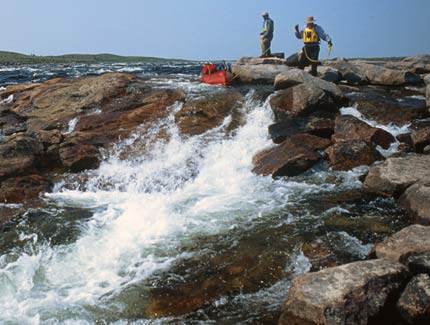
Route:
The Thlewiaza River is in the Territory of Nunavut, Canada, just north of the Manitoba border. In a van with four people, two canoes, and all our gear, we drove 20 hours and 40 minutes from Minneapolis/St. Paul, Minnesota to Lynn Lake, Manitoba. Then we stayed overnight in a motel and the following morning flew in a Twin Otter to Seal Hole Lake, just downstream from huge Nuelton Lake. From there we paddled194 miles downstream for 13 days to Hudson Bay and were picked up at the junction with the Tha-anne River by Joe Savikataaq Sr. and his son in their 22-foot boat. That boat took us 50 miles north to Arviat where we spent one night with Joe’s family. We explored Arviat for most of the day and in late afternoon, flew via commercial air to Thompson, Manitoba, where we stayed overnight in a motel. We paid to have our van shuttled from Lynn Lake to Thompson, Manitoba. The following day we drove 16 1/2 hours from Thompson back to the Twin Cities. Our canoes arrived in Thompson on a freight plane a few days after we departed for home, so another canoeing friend transported our canoes back to the Twin Cities.
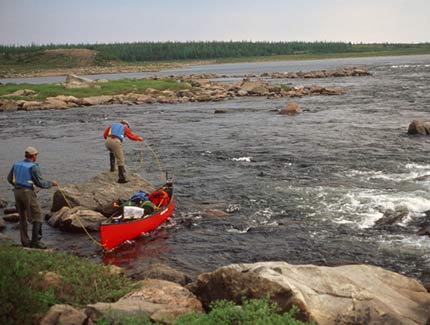
River Conditions:
The river had a moderate current with frequent swift water sections. It averaged 4.5 feet of drop per mile, but the drop varied from 1.1 to 21.9 feet per mile. We made good time paddling and easily averaged 15 miles per day. We got ahead of schedule in the first half of the trip and cut down to about 12 miles per day in the latter half. The topographic map showed frequent swiftwater marks. Most of those sections had standing waves, but we usually could find an easy route to run. Some swift water marks should have been labeled as rapids because there were ledges extending across the river. We typically could paddle to the top edge of a ledge, line over one end, and paddle onward. There were no portages on the trip! The river averaged ¼ to ½ mile wide, but varied considerably and often was wider. Local Inuit called it the Big River. There were several lakes along the route with Edehon and Ranger Seal the largest, but we had very little wind so these lakes did not slow us down. After Joe and Jamie picked us up in their boat near the mouth of the river, Hudson Bay had waves over 6 feet high so we stopped for several hours on a small island along with four other Inuit men who had come down from Arviat in two smaller power boats to hunt for beluga whales. We enjoyed several hours visiting with them about their life on Hudson Bay.
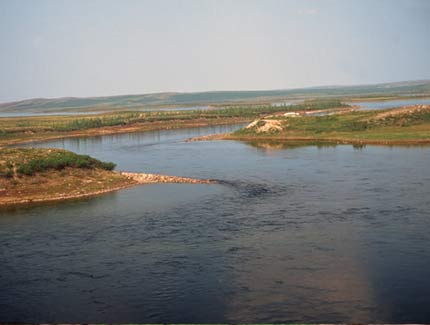
Campsites:
We always found good campsites on short tundra vegetation or sand, but often paddled two to three miles to find one after deciding to look for a site.
Topography:
The landscape was quite flat. The highest hills were only 275 feet above the river and most rose less than 40 feet. We really needed our 1:50,000 topographic maps to keep track of our position on the river and it took us two days to calibrate our eyes to match the flat landscape to the maps. At the water level we traveled, many islands on the map were actually seen as peninsulas of land or just beds of low-lying rocks.
Hiking was relatively easy but there were no really significant landscape features of great interest. One sand dune was the most interesting geologic feature. On hikes we found birds, bones, caribou antlers, scat, and animal tracks.
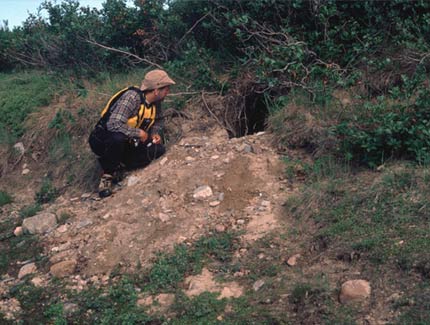
Vegetation:
Tundra predominated all along the river, but large patches of spruce and tamarack were common on the first half of the river. Willow, dwarf birch, and alder were common along the river’s edge. We also saw Labrador tea and bearberry. We built only a couple of small trash fires, but firewood was fairly common along the river, especially in the first week, although wood was not necessarily convenient to our campsites.
Insects, Fish, & Wildlife:
Mosquitos and black flies were quite bad. The bug tent we borrowed was well worth its weight.
Fishing was good during the first few days for grayling, lake trout, and northern pike, but thereafter we caught only grayling and an occasional northern pike. We caught no lake trout in the last half of the trip even though we often fished for them. Thlewiaza means “river of little fish,” probably in recognition of the abundant grayling which we caught all along the river, especially on dry flies and dark-colored plastic or marabou jigs.
Wildlife highlights were ranger seals which we saw throughout the trip and a huge herd of caribou at the end of our trip near Hudson Bay. We also saw gray wolf, weasel, siksik, lemming?, grizzly bear den, arctic hare, rock ptarmigan, Canada goose, whistling swan, king eider, scoter, red-breasted merganser, common loon, arctic loon, long-tailed jaeger, herring gull, glaucous gull?, arctic tern, short-billed dowitcher, sandpiper, and robin.
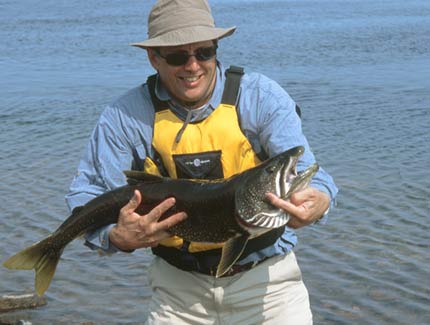
Weather:
The temperature typically ranged from the upper 40s to 50s at night and 60s to 70s during the day, but we had a few days that probably were over 80 degrees.
Canoes & Equipment:
We paddled an Old Town Discovery 174 and an Old Town Penobscot. Canoes had lining ropes, but no spray skirts. A 50 mph wind that arose one evening in five minutes time was a warning to make sure our canoes, tents, and gear were lashed down at all times around the campsite. We typically put rocks on top of our tent pegs as added security for our tents in a high wind. We set up a bug tent when winds were calm.
Motel: Lynn Inn Inc., 515 Sheritt Avenue, Lynn Lake, Manitoba, R0B 0W0 Canada; 204-356-2433; http://www.lynninn.ca/#!
Twin Otter from Lynn Lake, Manitoba to Seal Hole Lake, Nunavut: Trans West, Lynn Lake, Manitoba, (204) 356-2457; www.transwestair.com/html/Services/Charters/index.cfm
Car Shuttle from Lynn Lake to Thompson, Manitoba: Esso Gas Station, 527 Sherritt Avenue, Lynn Lake, Manitoba, R0B 0W0; Canada; (204) 356-8692
Park Vehicle in Thompson, Manitoba: Thompson Fire Department, (204) 677-7911
Boat Shuttle on Hudson Bay from Mouth of Tha-anne River to Arviat: Joe Savikataaq Sr., Arviat, Nunavut, W (867) 857-2976, H (867) 857-2771
Transport Canoes from Arviat to Thompson: Calm Air Cargo, In Arviat contact Eskimo Lumber Supply (867) 857-2518 or in Thompson (204) 677-0519.
Airline from Arviat to Thompson: Calm Air, www.calmair.com/main/
Satellite Phone Rental: Outfitter Satellite, Inc., Nashville, TN, (877) 436-2255 Ext #102
Sport Fishing License: Wildlife Service, Department of the Environment, Government of Nunavut,
Arviat, Nunavut Canada XOC OEO, (867) 857-2828, Fax: 867-857-2986
Topographic Maps 1 to 50,000 Scale: Geomatics Canada, http://maps.nrcan.gc.ca/topographic.html or
World of Maps: www.worldofmaps.com/
55 D10, 55D11, 55D5, 55D6, 65A6, 65A7, 65A8, 65A9, 65A10, 65A11, 65A12, 65B9, 65B10, 65B15
Average Cost Per Person $US:
19 Car shuttle from Lynn Lake to Thompson
13 Contribution to fire station in Thompson for van parking space
1,233 Twin Otter from Lynn Lake to Seal Hole Lake
40 Fishing license
115 Boat from mouth of The-anne River to Arviat
38 Lodging in Arviat at private home for 1 night
68 Motel in Lynn Lake and Thompson, 2 nights total
3 Transport canoes in Arviat from dock to airport
110 Fly canoes (Calm Air) from Arviat to Thompson
484 Calm Air flight from Arviat to Thompson
3 Cab from Thompson airport to fire station to pick up van
71 Meals on the road and in Arviat (estimated)
99 Food, liquor, and stove fuel on canoe trip
48 Satellite phone
9 Smoke flares
103 Gas for van, Minneapolis to Lynn Lake and return
2,456 Total cost per person
– See more at: https://canoeing.com/rendezvous/triplogs/triplog15_mbaughman-19.htm#sthash.WWCZfnII.dpuf



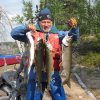
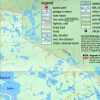












Nice write up. In 2001 my group flew from Lynn Lake to Lac Brochet and went all of the way to the bay along the Thlewiaza. We also were picked up by Joe. Great guy. We had a very intense polar bear encounter at the end of the trip. I wouldn’t go to this part of the world with out a 12 Ga Shotgun, it saved our lives. Would definitely go again.